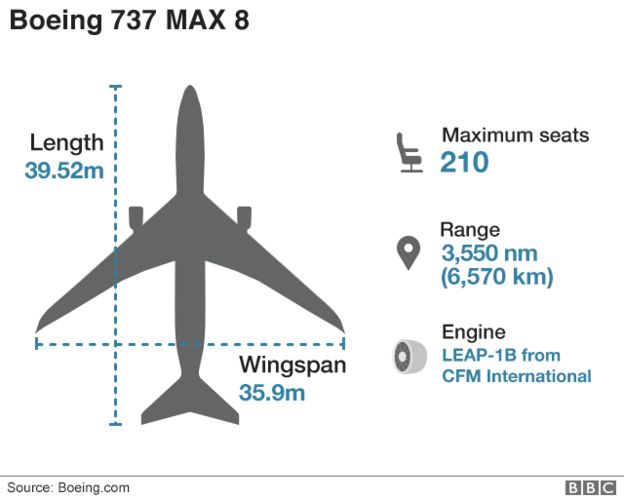US plane maker Boeing is facing questions after an Ethiopian Airlines 737 crash on Sunday killed all 157 people on board.
It was the second crash in five months involving a 737 Max 8, and comparisons are being drawn with a Lion Air accident in Indonesia last October.
In response, a number of airlines have now grounded all planes of the same model.
However, experts warn it is too early to say what caused the latest disaster.
Ethiopian Airlines says the plane, flight ET302, crashed at 08:44 local time (05:44 GMT), just six minutes after it left Addis Ababa. The aircraft, bound for Nairobi, came down near the town of Bishoftu, 60km (37 miles) south-east of the capital.
The pilot had reported difficulties and had asked to return to Addis Ababa, the airline said.
“At this stage, we cannot rule out anything,” Ethiopian Airlines CEO Tewolde Gebremariam told reporters at Bole International Airport in the capital.
Visibility was said to be good but air traffic monitor Flightradar24 reported that the plane’s “vertical speed was unstable after take-off”.
The pilot was named as Senior Captain Yared Getachew who had a “commendable performance” with more than 8,000 hours in the air, the airline said.
Passengers from more than 30 countries were on board the flight, including 32 Kenyans, 18 Canadians, and seven Britons.
At least 19 victims were affiliated with the United Nations, according to a UN official.
Some passengers were heading to a session of the UN Environment Assembly in Nairobi which began with a minute’s silence on Monday.
Slovak MP Anton Hrnko also confirmed via Facebook that his wife and two children were on the plane.
Meanwhile, a Greek man has said that he was due to board the flight but arrived at the gate two minutes late.
In a Facebook post, Antonis Mavropoulos shared an image of his ticket and said it was his “lucky day”.
“I was angry because nobody helped me to reach the gate on time,” he wrote. “I’m grateful to be alive.”
In Ethiopia, Monday has been declared as a national day of mourning.
The 737 Max-8 aircraft has only been in commercial use since 2017.
The plane that crashed was among six of 30 that Ethiopian Airlines had ordered as part of its expansion. It underwent a “rigorous first check maintenance” on 4 February, the airline tweeted.
Boeing said it was “deeply saddened” by the crash and is sending a team to provide technical assistance.


Following the Lion Air crash last October, investigators said the pilots had appeared to struggle with an automated system designed to keep the plane from stalling – a new feature of the Boeing 737 Max.
The anti-stall system repeatedly forced the plane’s nose down, despite efforts by pilots to correct this, preliminary findings suggest. The crash killed 189 people.
The Lion Air plane was also new and the accident happened soon after take-off.
“It’s highly suspicious,” Mary Schiavo, former Inspector General of the US Transportation Department, told CNN.
“Here we have a brand-new aircraft that’s gone down twice in a year. That rings alarm bells in the aviation industry, because that just doesn’t happen.”
After last October’s crash, Boeing sent an emergency notice to airlines warning them of a problem with the anti-stall system.
Boeing is expected to release a software patch to the system to deal with this issue, according to Reuters.
However, with the Ethiopian Airlines investigation at an early stage, it is not clear whether the anti-stall system was the cause of Sunday’s crash. Aviation experts say other technical issues or human error cannot be discounted.
Ethiopian Airlines has a good safety reputation, although in 2010 one of the company’s aeroplanes crashed in the Mediterranean Sea shortly after leaving Beirut



